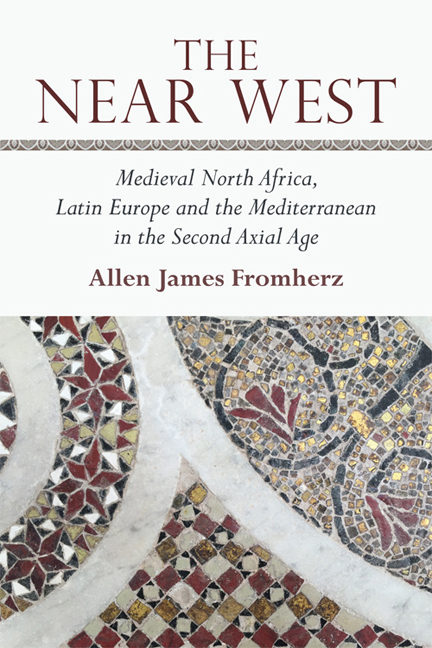Book contents
- Frontmatter
- Contents
- Map: The Near West – Medieval North Africa and Europe
- Personal Note and Acknowledgments
- Introduction: North Africa and the Mediterranean Paradox
- 1 Bèjaïa: Introducing North Africa, Latin Europe and the Mediterranean
- 2 Rome: North Africa and the Papacy
- 3 Tunis: Axis of the Middle Sea
- 4 Marrakech: The Founding of a City
- 5 The Almohads: Empire of the Western Mediterranean
- 6 Between City and Countryside: Ibn Khaldun and the Fourteenth Century
- 7 Conclusions: A Second Axial Age
- Notes
- Bibliography
- Index
5 - The Almohads: Empire of the Western Mediterranean
Published online by Cambridge University Press: 23 September 2017
- Frontmatter
- Contents
- Map: The Near West – Medieval North Africa and Europe
- Personal Note and Acknowledgments
- Introduction: North Africa and the Mediterranean Paradox
- 1 Bèjaïa: Introducing North Africa, Latin Europe and the Mediterranean
- 2 Rome: North Africa and the Papacy
- 3 Tunis: Axis of the Middle Sea
- 4 Marrakech: The Founding of a City
- 5 The Almohads: Empire of the Western Mediterranean
- 6 Between City and Countryside: Ibn Khaldun and the Fourteenth Century
- 7 Conclusions: A Second Axial Age
- Notes
- Bibliography
- Index
Summary
The fascinating life of the Almohad admiral Ahmad Al-Siqilli (of Sicily) mirrored the close interactions between Christian and Muslim Mediterraneans in this period. The Normans under Roger II of Sicily, also known for his patronage of the geographer Al-Idrisi, had captured Al-Siqilli as a young man. Ahmad Al-Siqilli was then trained in the arts of the admiralty. After the death of Roger, Ahmad fled to Tunis and Marrakech where he joined the court of the Almohad Caliph Yusuf bin ‘Abd Al-Mu’min. The Caliph declared him commander of the fleet. Ahmad and his ships were able to fight Christian forces so effectively that his fame spread throughout the Muslim world. Even Salah Al-Din Yusuf bin Ayyub (the famed “Saladin” who drove the crusaders out of Jerusalem in 1187) sent a close member of his family to the court of the Caliph Ya‘qub Al-Mansur begging for the support of the Almohad navy. Perhaps for the sake of prudence or perhaps because Ya‘qub Al-Mansur felt he was the greater anti-crusader, the true leader of the Muslims, Saladin's envoy was sent back.
The almost unprecedented power of the Almohads over the seas was reflected in the confidence of their architecture and art. Just as the success of the Italian city-states in the Eastern Mediterranean produced a flowering in architecture and culture, the success and confidence of the Almohads in the Western Mediterranean was expressed in their massive and austere architecture. The Almohad Giralda Mosque of Seville, whose minaret remains as the bell tower of the cathedral of Seville, outshone most mosques of the East. The Almohads often used architects and artists from throughout the Mediterranean. Many of these came from as far away as Sicily (then under Christian control). Like the admiral Ahmad Al-Siqilli, the architect of the Giralda was Abu Layth Al-Siqilli (from Sicily), showing the lasting Mediterranean influences of the architectural styles of the Almohad Empire. If finished, the enormous Hassan Mosque in Rabat, now the capital of Morocco, could have quite easily been one of the largest mosques in all of Islam, as great as Damascus, Baghdad or Mecca. Rabat itself was founded as a monumental city, a proclamation of jihad, a statement in stone and mortar to the duty to spread the universal ideal of Almohad doctrine, the ineffable unity of God.
- Type
- Chapter
- Information
- The Near WestMedieval North Africa, Latin Europe and the Mediterranean in the Second Axial Age, pp. 145 - 193Publisher: Edinburgh University PressPrint publication year: 2016



